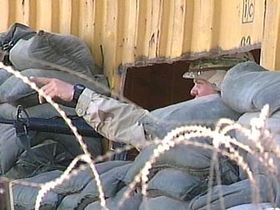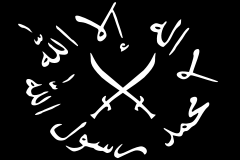Somali Civil War
| Somalia Civil War | |||||||
|---|---|---|---|---|---|---|---|
 A Black Hawk helicopter, callsign Super 6-4, hovering over the Mogadishu coast. |
|||||||
|
|||||||
| Casualties and losses | |||||||
| Casualties: 300,000[1] - 400,000[2] dead |
|||||||
|
|||||
|
|||||
The Somali Civil War is an ongoing civil war taking place in Somalia. The conflict, which began in 1991, has caused destabilisation and instability throughout the country, with the current phase of the conflict seeing the Somali government losing substantial control of the state to rebel forces.
From 2006-2009, the National Defense Force of Ethiopia was involved in the conflict. Somalia's government declared a state of emergency in June 2009,[3] requesting immediate international support, and the military intervention of neighbouring East African states.[4]
Contents |
Downfall of Siad Barre (1986–1992)
The first phase of the civil war stemmed from the insurrections against the repressive regime of Siad Barre. After his ousting from power on January 26, 1991, a counter-revolution took place to attempt to reinstate him as leader of the country.
The increasingly violent and chaotic situation evolved to a humanitarian crisis and to a state of anomie.
Later in 1991, to insulate it from the more violent fighting in the south, the Somaliland region of Somalia declared itself independent, though its sovereignty is not recognized by any nation or international organization. It comprises the northwestern section of the country, between Djibouti and the northeastern area known as Puntland.
UN intervention (1992–1995)
UN Security Council Resolution 733 and UN Security Council Resolution 746 led to the creation of UNOSOM I, the first mission to provide humanitarian relief and help restore order in Somalia after the dissolution of its central government.
UN Security Council Resolution 794 was unanimously passed on December 3, 1992, which approved a coalition of United Nations peacekeepers led by the United States to form UNITAF, tasked with ensuring humanitarian aid be distributed and peace be established in Somalia. The UN humanitarian troops landed in 1993 and started a two-year effort (primarily in the south) to alleviate famine conditions.

Critics of US involvement pointed out that "just before pro-U.S. President Mohamed Siad Barre was overthrown in 1991, nearly two-thirds of the country's territory had been granted as oil concessions to Conoco, Amoco, Chevron and Phillips. Conoco even lent its Mogadishu corporate compound to the U.S. embassy a few days before the Marines landed, with the first Bush administration's special envoy using it as his temporary headquarters."[5][6][7]
Many believed that the US was stepping in to gain control of oil concessions. Somalia has no proven reserves of oil, but there are considered to be possible reserves off Puntland. Even today, oil exploration remains a controversy. The Transitional Federal Government has warned investors to not make deals until stability is once again brought to the country.[8]
In the period between June and October, 1993, several gun battles in Mogadishu between local gunmen and peacekeepers resulted in the death of 24 Pakistanis and 19 US soldiers (total US deaths were 31), most of whom were killed in the Battle of Mogadishu. 1000 Somali militia were killed in that battle. The Security Council in Resolution 837 condemned the attacks.
The incident later became the basis for the book and movie, Black Hawk Down. The UN withdrew on March 3, 1995, having suffered more significant casualties. Order in Somalia still had not been restored.
Rise and fall of the ICU, Ethiopian intervention, and the TFG (2006–2009)

In 2004, the Transitional Federal Government (TFG) was founded in Nairobi, Kenya. Matters were still too chaotic inside Somalia to convene in Mogadishu. In early 2006, the TFG moved to establish a temporary seat of government in Baidoa.
During the early part of 2006, the Alliance for the Restoration of Peace and Counter-Terrorism (ARPCT) was formed as an alliance of mostly secular Mogadishu-based warlords. They were opposed to the rise of the Sharia law oriented Islamic Courts Union (ICU), which had been rapidly consolidating power. They were backed by funding from the US CIA.[9] This led to increasing conflict in the capital.
Height of ICU power
By June 2006, the ICU succeeded in capturing the capital, Mogadishu, in the Second Battle of Mogadishu. They drove the ARPCT out of Mogadishu, and succeeded in persuading or forcing other warlords to join their faction. Their power base grew as they expanded to the borders of Puntland and took over southern and middle Jubaland.
The Islamic movement's growing power base and militancy led to increasingly open warfare between the Islamists and the other factions of Somalia, including the Transitional Federal Government (TFG), Puntland and Galmudug, the latter of which formed as an autonomous state specifically to resist the Islamists. It also caused the intervention of Ethiopia, who supported the secular forces of Somalia. The ICU allegedly obtained the support of Ethiopia's rival, Eritrea and foreign mujahideen, and declared Jihad against Ethiopia in response to its occupation of Gedo and deployment around Baidoa.
Ethiopian intervention and collapse of the ICU
In December 2006, the ICU and TFG began the Battle of Baidoa. Fighting also broke out around the Somali town of Bandiradley in Mudug and Beledweyn in Hiran region. The ICU aimed to force the Ethiopians off Somali soil. However, they were defeated in all major battles and forced to withdraw to Mogadishu. After the brief final action at the Battle of Jowhar on December 27, the leaders of the ICU resigned.
Following the Battle of Jilib, fought December 31, 2006, Kismayo fell to the TFG and Ethiopian forces, on January 1, 2007. Prime Minister Ali Mohammed Ghedi called for the country to begin disarming.
US intervention
In January 2007, the United States officially militarily interceded in the country for the first time since the UN deployment of the 1990s by conducting airstrikes using AC-130 gunships against Islamist positions in Ras Kamboni, as part of efforts to catch or kill Al Qaeda operatives supposedly embedded within the ICU forces. Unconfirmed reports also stated that US advisors had been on the ground with Somali and Ethiopian forces since the beginning of the war. Naval forces were also deployed offshore to prevent escape by sea, and the border to Kenya was closed.
Islamist insurgency and reappearance of inter-clan fighting
No sooner had the ICU been routed from the battlefield than their troops dispersed to begin a guerrilla warfare against Ethiopian and Somali government forces. Simultaneously, the end of the war was followed by a continuation of existing tribal conflicts.
To help establish security, a proposed African Union Mission to Somalia (AMISOM) was authorized to deploy as many as 8,000 peacekeepers to the country. This mission widened the scope of countries that could participate over the earlier proposed mission led by the Horn of Africa-based nations of IGAD. The Islamist group leading the insurgency, known as the Popular Resistance Movement in the Land of the Two Migrations (PRM), vowed to oppose the presence of foreign troops.
War in Somalia (2009–present)
In December 2008, Ethiopian soldiers withdrew from Somalia, leaving behind an African Union contingent of several thousand troops to help the fragile coalition government and its troops enforce their authority. Following Ethiopia's withdrawal from Somalia, the southern half of the country rapidly fell into the hands of radical Islamist rebels. The rebels quickly routed the government and AU troops in several key provinces, establishing sharia law in areas under their control. On May 7 2009, the rebels attacked the capital city of Mogadishu, capturing most of the city but failing to overthrow the government, which maintained control over a few square kilometers of the city.
See also
- Factions in the Somali Civil War
- Puntland–Somaliland dispute
- Mogadishu Line
Notes
- ↑ Hundreds of thousands killed inmany years of war, says new president
- ↑ Twentieth Century Atlas - Death Tolls and Casualty Statistics for Wars, Dictatorships and Genocides
- ↑ The Associated Press. "Somali Cabinet OKs state of emergency". Google. http://www.google.com/hostednews/ap/article/ALeqM5g7OaI4_kjeHA-o4UhlmP7vlWmrrwD98UDFL01. Retrieved 2009-06-21.
- ↑ "Ethiopia rejects Somali request". BBC News. June 21, 2009. http://news.bbc.co.uk/2/hi/africa/8111312.stm. Retrieved 2009-06-21.
- ↑ Kretzman, Steve (Jan/Feb 2003). "Oil, Security, War The geopolitics of U.S. energy planning". Multinational Monitor magazine. http://www.thirdworldtraveler.com/Oil_watch/Oil_Security_War.html.
- ↑ Fineman, Mark (January 18 1993). "Column One; The Oil Factor In Somalia;Four American Petroleum Giants Had Agreements With The African Nation Before Its Civil War Began. They Could Reap Big Rewards If Peace Is Restored.". Los Angeles Times: 1. http://bailey83221.livejournal.com/70509.html.
- ↑ George, Dev (1995). "Will the majors return to Somalia?". Offshore: 8. http://bailey83221.livejournal.com/70792.html.
- ↑ "Abdillahi Yusuf’s Transitional Government And Puntland Oil Deals". Somaliland Times. http://www.somalilandtimes.net/196/10728.shtml. Retrieved 2007-01-10.
- ↑ UN trying to clarify problems in Somalia - The Final Call - Jun 29, 2006
External links
- News coverage of conflict
- Somalia in crisis collection of articles on the BBC
- Somalia's Struggle for Stability from The NewsHour with Jim Lehrer
- The Somalia Affair from CBC
- Somalia - War situation since 1991 on France 24 Special Report on France 24 news channel
- U.S. Special Envoy Cites Widespread ‘Lack of Confidence’ in Somali Government from the Council on Foreign Relations
- ITN/CNN Report "War tears Somalia apart", an up-to-date report on Mogadishu, October, 10th, 2007.
- HRW claims US involved in secret detention of Somalis, Breaking Legal News 2007/04/01
- Anarchy and Invention: How Does Somalia's Private Sector Cope without Government? from the World Bank
- Turbulent Waters in a Maritime Black Hole The Hague Centre for Strategic Studies May 2008
- Condemn US-Ethiopian aggression against Somalia Lalkar January 2007
- Somalia Operations: Lessons Learned by Kenneth Allard (CCRP, 1995)
- From Nation-State to Stateless Nation: The Somali Experience by Michael van Notten (Amsterdam, 2000)
- "Preserving American Security Ties to Somalia," by Michael Johns, Heritage Foundation, December 26, 1989.
- Changed Arab attitudes to Somalia Conflict
- "Separation Anxiety", article in The Walrus about post-traumatic stress disorder among Somali warriors
- Between Kat and Katyushas Elaborated Article on the Contemporary History of Somalia